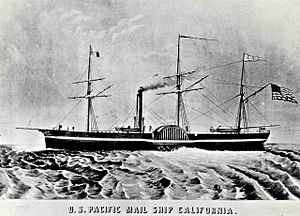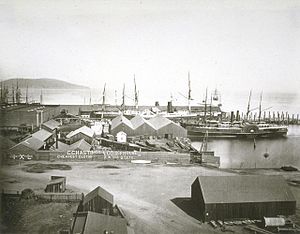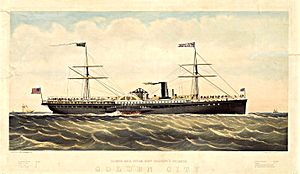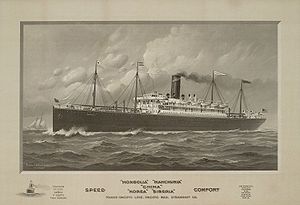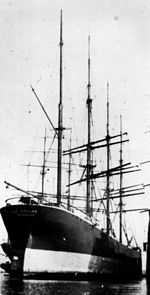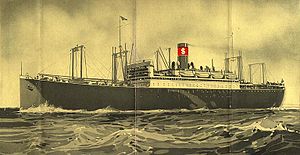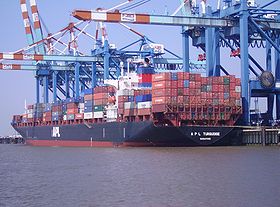- American President Lines
-
American President Lines Ltd. 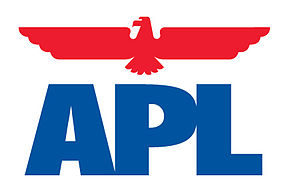
Type Public Industry Shipping
LogisticsFounded 1849 Headquarters Scottsdale, Arizona Key people Eng Aik Meng (President & CEO) Services Container Shipping
TerminalsRevenue  US$ 9.42 billion (2010)
US$ 9.42 billion (2010)Employees 19,500 (2010) Parent Neptune Orient Lines Website apl.com American President Lines Ltd. (now simply referred to as APL) is the world's fourth-largest container transportation and shipping company,[1][2] providing services to more than 140 countries[3] through a network combining intermodal freight transport operations with IT and e-commerce. It is a wholly owned subsidiary of Neptune Orient Lines (NOL), based in Singapore, a global transportation and logistics company engaged in shipping and related businesses.[4][5] APL has offices in almost 100 countries worldwide.[6] The APL United States regional headquarters is in Scottsdale, Arizona.[7]
APL and its predecessors once were engaged in passenger service serving the Asia-Pacific route, among others. However, these ceased in 1973. Liners included the SS President Cleveland and the SS President Wilson.[8][9]
In 1938 the U.S. Government took over the management of the Dollar Steamship Co. which was in financial difficulties and transferred their assets to the newly formed American President Line.[8]
The company operated trans-Pacific and round-the-world services, but the war in Europe disrupted services and after the entry of the United States into the war, all the company's ships were taken over for war duties under the War Shipping Administration.[8][10]
Contents
History
Pacific Mail Steamship Company
Following the end of the Mexican-American War in 1848, the United States Pacific coastline now extended from Puget Sound to San Diego. When the 29th Congress passed the Mail Steamer Bill (1847), mail delivery was authorized to be routed by ship from the Eastern Seaboard to the Pacific Coast via the Isthmus of Panama, with two steamship routes operating: New York City to Chagres, Colombia on the Eastern side of the isthmus, and then a second route from Panama, Colombia to Astoria, Oregon. That same year, William Henry Aspinwall secured a 10-year government contract through Arnold Harris, with the New York State Senate incorporating the Pacific Mail Steamship Company with a capital of $400,000, of which Aspinwall was elected the first president. This company was to move the mail from Panama to the West Coast, being paid $199,000 per annum by the U.S. Government. In January 1848, the company ordered three mail steamers from the shipyard of William Henry Webb: the SS California, SS Panama and SS Oregon. On October 5[11] or October 6,[12][13][14] 1848 the Pacific Mail's first of these steamers, the SS California, departed from New York City to run service from Panama to the West Coast, traveling around Cape Horn to San Francisco—coincidentally, the California Gold Rush began in January of that year, and the steamer—and its sisters, Oregon and Panama—took on many hopeful miners en route.[11][12][13][14]
Prior to founding Pacific Mail, Aspinwall had extensive experience in the shipping business as a partner in Howland & Aspinwall. Howland & Aspinwall operated some of the most famous clipper ships ever built. In 1845, while it already owned the Ann McKim, which was regarded as the fastest ship afloat, the firm built the Rainbow, which was even faster. The Rainbow is considered to be the first of the extreme clippers, which were the racehorses of the sea. The next year, the company had the Sea Witch built, which set a speed record from China to New York which still stands.[15]
Clipper ships sacrificed cargo capacity for speed, but in some markets, the fast service allowed their owners to charge premium rates (Tea from China tasted better if it was fresh, so the cargo on the first ship of the season to arrive in New York was worth more). Also, faster speed meant that the vessel could complete more voyages in a given time period, which also helped make up for the diminished cargo capacity.
When in 1850 the Pacific Mail Steamship Company established a competing line to the U.S. Mail Steamship Company between New York and Chagres, George Law placed an opposition Pacific Line of steamers (SS Antelope, SS Columbus, SS Isthmus, SS Republic) in the Pacific running from Panama to San Francisco. In April 1851, the rivalry was ended when an agreement was made between the companies, the U.S. Mail Steamship Company purchased the Pacific Mail steamers on the Atlantic side (SS Crescent City, SS Empire City, SS Philadelphia), and George Law sold his ships and new line to the Pacific Mail.
By 1850 Pacific Mail maintained a monopoly over the Panama-Oregon trade, helped by the purchase of two steamers from Empire City Line. Large numbers of prospective gold miners paying for passage to California had meant that by 1850, the capital of Pacific Mail had increased from $400,000 to over $2 million. Pacific Mail also ordered four new ships, designed to meet the needs of trade to and from California, and opened ship depots at Panama City and Benicia, California. Aspinwall invested in the Panama Railroad Company, which would replace old wagon trails across the Isthmus, cutting travel time from four days to four hours. In 1852, George Law went into partnership with Aspinwall and developed its eastern terminal next to the wharf at Aspinwall, Columbia, then sold his interest in 1853. This line was completed in 1855, and coordination between steamships and this line meant the travel time from San Francisco to New York was cut to 21 days.
In 1856, Aspinwall retired from the position of president of the Pacific Mail Company, with the former secretary, William H. Davidge, taking the presidency. Under his control, the company's capital doubled, to $4 million, but the major turning point of his presidency of the company was in 1858, when Pacific Mail's contract with the government expired. However, at the same time, the contract of the U.S. Mail Steamship Company also expired. This company had been providing the ships for the New York to Panama route and went out of business in 1859. A through service was deemed necessary (and profitable), and the company bought three new ships: the SS Adriatic, SS Atlantic and SS Baltic, all of which had formerly belonged to Collins Line. However, competition from the other Atlantic steamship lines was fierce, and within a few years, the route on the Atlantic side was pulled.[11][13]
During the Civil War (1861–1865), Pacific Mail used its steamers to transport gold to the East Coast to support the Northern cause. The company also received the SS Colorado, launched from the same shipyard as the SS California. By the end of the war (1865), under the new presidency, Pacific Mail purchased its competitor, Atlantic Mail Steamship Company, which at this point was providing service from New York to the Isthmus. This in turn meant that, at last, Pacific Mail was able to provide complete service from New York to the West Coast via the Isthmus, without competition.[13]
In 1866, the U.S. Government awarded the first mail contract of $500,000 per annum between San Francisco and the Far East — namely Hong Kong via Japan and the Sandwich Islands (later known as the Hawaiian Islands) — to Pacific Mail. The SS Colorado was pulled from the original New York–San Francisco route to be used on the new route from San Francisco to China and Japan. The Colorado was outfitted with a mizzen mast and more coal storage for the voyage, and in 1867, became the first steamship to run a regular service across the Pacific Ocean, running from San Francisco to Yokohama, Japan and onward to Hong Kong. Pacific Mail also ordered four new ships to run on this route: the SS China, SS Japan, SS Great Republic and SS America. These ships were ordered at a cost of $1 million, and the capital of the company was increased to $20 million to cover this cost.[11][13][14]
By 1867, the company was running four different lines:
- The Atlantic Line, between New York and Aspinwall, Panama. This ran thrice monthly.
- The Pacific Line, which linked with the Atlantic Line, which ran between Panama and San Francisco, stopping at Acapulco and Manzanillo. This route also ran thrice monthly, except for the latter, which ran once monthly.
- The China Line, between San Francisco and Hong Kong, stopping at Yokohama. This ran once monthly. This linked with the Pacific Line.
- The Shanghai Line, which ran between Yokohama and Shanghai, via Nagasaki. This also ran once monthly, linking with the China Line.
Through these links, freight could be moved from New York to Yokohama in 42 days, to Shanghai in 47 days and Hong Kong in 50 days, including all detentions. In this same year, the company owned 25 ships, with a combined tonnage of 61,474 tons.[11]
In 1869, the completion of the Transcontinental Railroad meant that the passenger traffic on the Panama route declined. However, in 1872, the U.S. government doubled the subsidy on mail transported by Pacific Mail, although it required the doubling of service and the modernization of the fleet. Therefore, in 1873, Pacific Mail took delivery of the first of 11 iron–hulled, screw-powered steamships, the City of Peking. In 1875, William Henry Aspinwall, died on January 18 at the age of 68, but Pacific Mail continued on, and soon began service to Australia and New Zealand.[13][16]
During the 1880s Pacific Mail modernized its ships with steel hulls, replacing the old iron vessels, and installed electric lighting by Thomas Edison on the SS Columbia, making it the first ship to have electrical power in the world. In 1893, the Southern Pacific Co. acquired control over the Pacific Mail. In 1902, Pacific Mail launched the SS Korea and SS Siberia, which were its first steel-hulled ships, followed by SS Manchuria and SS Mongolia in 1904. These ships were the largest and fastest passenger-freight ships in the Pacific, the latter two measuring more than 13,600 gross tons, larger than any other ship the company owned at the time.[8][13][16][17]
In 1912, Congress banned ships owned by railroads from using the Panama Canal, and so Pacific Mail was sold to Grace Steamship Company, where it operated as a subsidiary from 1916 to 1925, when the company was bought by the Dollar Shipping Company.[13][16]
Dollar Shipping Company
Meanwhile, Captain Robert Dollar purchased his first ship marking the beginning of his shipping empire. Dollar was born in Falkirk, Scotland in 1844, moving to Canada at the age of 11, where he worked in a lumber camp. Following this, in 1893, he purchased his own sawmill on the Pacific Coast. However, due to unreliable shipping timetables, he found it hard to ship his lumber from the Pacific Northwest down the coast towards California. Hence, in 1893[16] or 1895,[13][18] Dollar bought a steam schooner called Newsboy. This led to the establishment of the Dollar Steamship Company (commonly known as "Dollar Line") on August 12, 1900, which soon grew to have a large fleet of schooners transporting lumber to market.[8][13][16][18]
In 1902, Dollar sailed to Asia for the first time on a Pacific Mail ship, the SS China, to prospect potential lumber markets on the other side of the Pacific. He began to acquire a number of ships, and began his trans-Pacific shipping with a chartered voyage to Yokohama, Japan and the Philippines, marking his entry into international shipping. During World War I, Dollar ordered the construction of $30 million worth of ships in China, and in 1923 bought seven "502 President Type" liners from the US Shipping Board, pioneering his round-the-world service, marked by the departure of SS President Harrison on January 5, 1924. These were all named after US presidents, a tradition that Dollar Shipping continued until its end.[8][16][18]
This was followed up in 1925 by the purchase of eight more "535 President Type" liners from the Shipping Board, which had previously been run by Pacific Mail. Dollar Shipping bid much lower than Pacific Mail for the ships — on the order of $1 million — but Pacific Mail's offer included stocks as well as cash. Thus, the Shipping Board declared that Pacific Mail was unable to meet the terms of tender, and awarded $30 million worth of ships to Dollar Shipping. This naturally caused troubles for Pacific Mail, and it was taken over by Dollar Shipping the same year, although Dollar had ordered his sons to begin buying stock of the company in 1920. The Dollar Line also acquired the Admiral Oriental Line, making it one of the most profitable shipping companies in the world.[8][16]
Dollar Line continued expanding its business in the late 1920s, buying five more "535 President Type" ships in 1926. In that year, Dollar Line carried over 45,000 passengers and had a gross revenue of $6 million. Dollar encouraged others to invest in Asia with his booklet, "Have You Investigated the Oriental Market for Your Product?", helping to open up Asia to 20th-century industry. The Merchant Marine Act of 1928 (also known as the Jones–White act) also helped Dollar Line, allowing it to sign a lucrative new mail contract and requiring it to build new ships to meet demand.[8][16]
The Wall Street Crash of 1929 led to the Great Depression, which naturally affected Dollar Steamship Line (renamed that same year). The company's two largest ships (both just under 22,000 tons), SS President Hoover and SS President Coolidge were completed in 1931, but even though they were state-of-the-art, luxurious vessels rivaling the best hotels of the era, the ships only carried half their capacity — 988 passengers accompanied by 324 crew — on their maiden voyages due to the depression.[8][19][20]
In 1932, Robert Dollar died at the age of 88 on May 16, being succeeded by his son, Robert Stanley Dollar. Following his death, the company began a steady decline. In 1937, the SS President Hoover ran aground off the coast of Taiwan, and was written off as a total loss. By 1938, The company was $7 million in debt, with interest increasing this by $80,000 per day. In August that year, the United States Maritime Commission judged the company to be unsound, assuming control and renaming it American President Lines[8][20]
American President Lines
By 1940, the US Government had commissioned 16 new ships for APL, continuing the "president" naming of ships, one of these examples being SS President Jackson, a C-3 class merchant vessel. In 1941, the US entered World War II, and in 1942 the War Shipping Administration was created, of which APL was an agent. APL worked on the management of some of the Administration's ships, maintaining and overhauling them as well as crewing them and being responsible for the handling of cargo and passengers. APL's own ships were used, in addition to the many Liberty and Victory ships that were built. In 1944, an additional 16 ships were built specifically for APL, including SS President Buchanan, a Victory class vessel. At the end of the war in 1945, the company's assets were valued at $40 million.[8][21]
One of the APL ships in World War II still survives. The S.S. Lane Victory is a Victory ship which is preserved as a museum ship in the San Pedro area of Los Angeles, California. As a rare surviving Victory ship, it is a U.S. National Historic Landmark. The Lane Victory was built by the California Shipbuilding Corporation in Los Angeles, California and launched on 31 May 1945.[22]
In 1945, R. Stanley Dollar, son of Robert Dollar, initiated court proceedings in the form of the Dollar case, in an attempt to force the return of the company from the government to his family. This case would last seven years, with the government continuing the operation of APL in the meantime. APL restarted its round-the-world passenger service, and launched the SS President Cleveland and SS President Wilson the next year, which were advertised as "your American hotel abroad." In the 1950s, the company again expanded, building more ships; 11 were built between 1952 and 1954. These included C-4 class cargo ships. Also, a settlement was finally reached in the Dollar case. Rather than the Dollar family taking back the company, it was sold to a group of investors led by Ralph K. Davies for $18.3 million.[8][21]
In 1958, the company began investigating the possibility of containerization, and sent investigation teams into 28 major ports. Following the reports, Davies began integrating containers into the company's business. By 1961, the company had begun launching ships capable of container transport, the first two of these being the SS President Tyler and SS President Lincoln. Ports also began adapting to the new container-based system, although many potential customers were still wary. By the end of the decade, the company was still launching more container-capable ships, and by 1969, 23% of the company's business moved via container.[8][21][23]
By 1971, the use of containers had again increased; 58% of the company's business moved via container. The increasing use of air travel meant that the company's passenger services had steadily been declining throughout the 1960s, and by 1973, the last liner, the SS President Wilson, completed her last round-the-world trip and was sold off. During the 1970s, the company continued to build new vessels capable of container transport, but pulled back from worldwide freight service to purely trans-Pacific routes only. In 1978, the company began work on the concept of intermodalism: the idea of moving containerized goods via ship, train and truck. By 1979, APL started the LinerTrain,[21][23][24] the first direct rail service transporting containers from Los Angeles to New York, leading to the most reliable delivery of containers at the time. At the same time, the company built its three largest vessels to date: three C-9 class diesel-powered container vessels, the first of which was the President Lincoln.[21][23][24]
In 1984, the company started StackTrain service,[21][23][24][25] an idea following on from the successful LinerTrain venture. This involved using double-stack cars, rail cars that could carry two containers on top of each other rather than carrying just a single container, due to the center of the car being lowered, hence the common name for double stack cars: "well cars." Previous versions had been tried, but the lack of a center depression meant that height restrictions severely limited their routes. The idea to lower the center of the car was invented by APL, along with rail car manufacturer Thrall. Service was provided by the Union Pacific Railroad and Norfolk Southern Railway.[21][23][24]
An interesting side effect was created by the design of the cars, which involved five permanently coupled cars in a set. This reduced the number of couplers, which meant that slack action was reduced. Slack is created in any train by the couplers between the cars being stretched and compressed, and in long, heavy trains this can be quite a powerful force. By reducing this, the company unexpectedly reduced the damage caused to the freight transported in containers.[24]
At the same time, the company continued to modernize its fleet, with ever larger and faster ships, all of which were outfitted for container transport. APL also started a door-to-door service, known as the Red Eagle service. Another initiative was to introduce larger container sizes: 45 ft (14 m) containers in 1982, 48 ft (15 m) containers in 1985 and 53 ft (16 m) containers in 1988. Also in 1988, the company developed post-Panamax vessels, those too large to transit the Panama Canal. These ships were 903 feet (275 m) long and 129 feet (39 m) wide, with the ability to carry 4300 TEUs, a TEU being an arbitrary container unit 20 feet (6.1 m) long. All these developments led APL to be declared an industry leader in 1989, with the award of the "Admiral of the Ocean Sea Award" by the United Seamen's Service to the president, W. Bruce Seaton.[21][23][24][25]
The 1990s were a period of continued growth for APL. It still clung to the tradition of naming ships after US presidents, and it had a fleet of 20 fully containerized ships at this point with a combined capacity of 20,000 TEUs. In 1991, APL started stack train service from Chicago to Mexico, serving Chrysler auto plants, as well as providing general service. The company also invested heavily in information technology, using this to keep track of its ever-growing fleet of trains, containers and ships. This has been continually upgraded ever since.[21][23][24]
In 1993, the company continued to increase its revenues, and entered a 30-year agreement with the Port of Los Angeles to open a new terminal, at a cost of $70 million. The next year, it almost doubled the size of its Seattle terminal as well, increasing it from 83 acres (340,000 m2) to 160. The company became the first shipper to open a website in 1995, and offered on-line shipment transactions. In 1997, the company was bought by Neptune Orient Lines for $285 million, at a cost of $33.50 per share.[23][24] In 1998, the APL vessel APL CHINA encountered a storm south of the Aleutian Islands. The loses to the cargo, with 388 containers going overboard and many others damaged as well as damage to the ship, initiated $50 million in lawsuit claims against APL. This may have been the largest maritime shipping loss in history.[26][27]
In 1999, the stack train franchise was sold off to Pacer, and is now known as Pacer Stacktrain. In the new millennium, the company's business began to falter. In 2001, parent company NOL reported losses of $57 million, followed by an amazing loss of $330 million in 2002. At this same time, APL's sales dropped from $3.8 billion in 2000 to $3.4 billion in 2002. Acting CEO Ron Widdows began a campaign of cost-cutting and sped up decision making, and since 2003, the company has been making money again. In 2005, the company introduced the "Real-Time Locating System" using RFID tags, which accurately recorded the position of every container within the system, reducing delays and lost containers—APL's Global Gateway South terminal in Los Angeles now moves 1.65 million TEUs annually.[21][23][24][28]
References
- ^ Niven, John, The American President Lines and its Forebears 1948–1984, p. 15, University of Delaware Press, Newark, New Jersey, 1987.
- ^ "Liner market shares". BRS report for Alphaliner. January 2006. http://www.brs-paris.com/newsletters/liner_studies/no29/.
- ^ "APL: Routes". APL. 2008-07-01. http://www.apl.com/routes/index.html.
- ^ Elias, Rahita, Beyond Boundaries: The First 35 Years of the NOL Story, p. 8, Neptune Orient Lines Ltd., 2004.
- ^ "Welcome to NOL: Corporate Structure". NOL. 2008-07-01. http://www.nol.com.sg/about/corpStruc.html.
- ^ "APL: Offices—Global Capabilities, Local Expertise". APL. 2008-07-01. http://www.apl.com/offices/.
- ^ [1] -US regionl headquarters
- ^ a b c d e f g h i j k l m "APL: History—Timeline: 1900–1959". APL. 2008-07-01. http://www.apl.com/history/html/timeline_02.html.
- ^ "The Ships List—American President Line". S. Swiggum & M. Kohli. 2008-07-05. http://www.theshipslist.com/ships/lines/americanpresident.htm.
- ^ "APL: History—A Call To Arms". APL. 2008-07-01. http://www.apl.com/history/html/overview_prosper_war.html.
- ^ a b c d e Otis, Fessenden (1867). "Pacific Mail Steam-Ship Company". Isthmus of Panama. New York: Harper & Brothers. pp. 149–167. http://www.mysticseaport.org/library/initiative/ImPage.cfm?BibID=17595&ChapterId=8. Retrieved 2008-06-02.
- ^ a b "APL: History—The First Voyage". APL. 2008-07-01. http://www.apl.com/history/html/overview_explore_calif.html.
- ^ a b c d e f g h i j "APL: History—Timeline: 1846–1899". APL. 2008-07-01. http://www.apl.com/history/html/timeline_01.html.
- ^ a b c "The Maritime Heritage Project: Captains, Ships, Passengers in 1800s California—Steamships". D.A. Levy/The Maritime Heritage Project. 2008-07-01. http://www.maritimeheritage.org/ships/ss.html.
- ^ Somerville, Col. Duncan S., The Aspinwall Empire, p. 22, Mystic Seaport Museum, Inc., Mystic, Connecticut, 1983.
- ^ a b c d e f g h "The Maritime Heritage Project: Captains, Ships, Passengers in 1800s California—Shipping Lines". D.A. Levy/The Maritime Heritage Project. 2008-07-01. http://www.maritimeheritage.org/ships/shippingLines.html.
- ^ "The Ships List—Pacific Mail SS Co.". S. Swiggum & M. Kohli. 2008-07-02. http://www.theshipslist.com/ships/lines/pacificmail.htm.
- ^ a b c "APL: History—Robert Dollar, 1844–1932". APL. 2008-07-01. http://www.apl.com/history/html/overview_explore_dollar.html.
- ^ "APL: History—Travelling in Style". APL. 2008-07-01. http://www.apl.com/history/html/overview_innovate_passenger.html.
- ^ a b "The Ships List—Dollar SS Company". S. Swiggum & M. Kohli. 2008-07-01. http://www.theshipslist.com/ships/lines/dollar.htm.
- ^ a b c d e f g h i j "Funding Universe—APL Limited Company History". Funding Universe. 2008-07-05. http://www.fundinguniverse.com/company-histories/APL-Limited-Company-History.html.
- ^ "Welcome Aboard the S.S. Lane Victory", U.S. Merchant Marine Veterans of World War II Web site (http://www.lanevictory.org/index.php) Retrieved 7-31-11.
- ^ a b c d e f g h i "APL: History—Timeline: 1960–Present". APL. 2008-07-05. http://www.apl.com/history/html/timeline_03.html.
- ^ a b c d e f g h i "Seaports Press Review—APL's Significant Contributions to Containerization". Seaports Press Review. 2008-07-05. http://www.seaportspr.com/viewtechnews.cgi?newsletter_id=49&article_id=2200.
- ^ a b "Pacer Stacktrain—History". Pacer Stacktrain. 2008-07-05. http://www.pacerstack.com/about/history_notlogged.html.
- ^ "Lawsuits rock APL's boat". San Francisco Business Times. November 22, 1998. http://www.bizjournals.com/sanfrancisco/stories/1998/11/23/story1.html#.
- ^ "Ship disaster leaves APL lost in sea of legal woes". San Francisco Business Times. March 21, 1999. http://www.bizjournals.com/sanfrancisco/stories/1999/03/22/focus2.html#.
- ^ "Eagle Marine Services—Los Angeles". Eagle Marine Services. 2008-07-05. http://www.eaglemarineservices.com/la/.
External links
- APL website
- NOL Group website (includes reports and financial information)
- [2] SS Jeremiah O'Brien - Liberty Ship website
- [3] SS Lane Victory - Victory Ship website
United States-flag shipping companies Ship operators APL · Hapag-Lloyd USA · Intermarine · Maersk Line · Matson Navigation Company · OSG Ship Management · Sealift Incorporated · TransAtlantic Lines · Waterman SteamshipTug & Barge operators: Categories:- Container shipping companies of the United States
- Temasek Holdings
Wikimedia Foundation. 2010.

